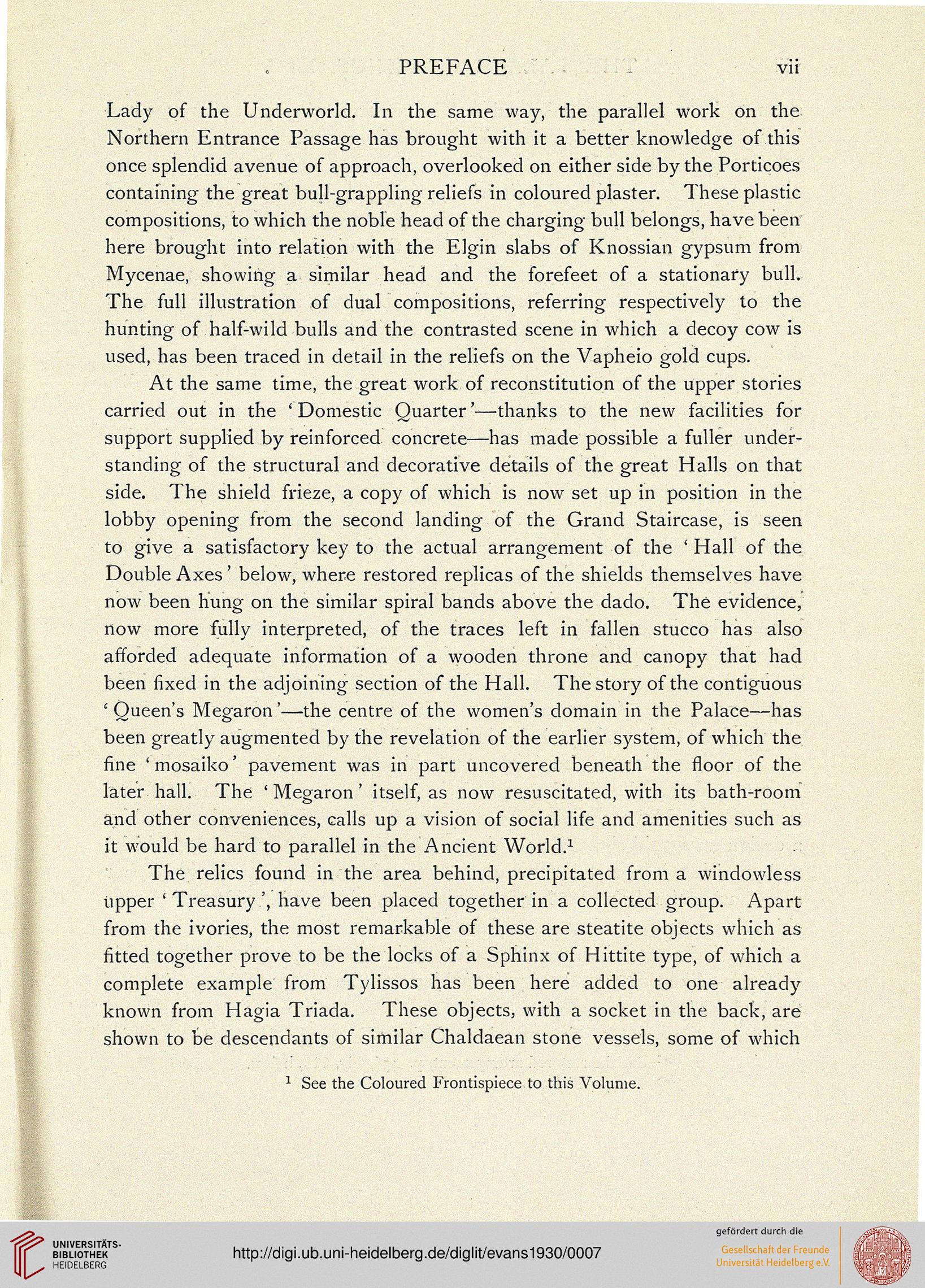PREFACE . • vii
Lady of the Underworld. In the same way, the parallel work on the
Northern Entrance Passage has brought with it a better knowledge of this
once splendid avenue of approach, overlooked on either side by the Porticoes
containing the great bull-grappling reliefs in coloured plaster. These plastic
compositions, to which the noble head of the charging bull belongs, have been
here brought into relation with the Elgin slabs of Knossian gypsum from
Mycenae, showing a similar head and the forefeet of a stationary bull.
The full illustration of dual compositions, referring respectively to the
hunting of half-wild bulls and the contrasted scene in which a decoy cow is
used, has been traced in detail in the reliefs on the Vapheio gold cups.
At the same time, the great work of reconstitution of the upper stories
carried out in the ' Domestic Quarter'—thanks to the new facilities for
support supplied by reinforced concrete—has made possible a fuller under-
standing of the structural and decorative details of the great Halls on that
side. The shield frieze, a copy of which is now set up in position in the
lobby opening from the second landing of the Grand Staircase, is seen
to give a satisfactory key to the actual arrangement of the ' Hall of the
Double Axes ' below, where restored replicas of the shields themselves have
now been hung on the similar spiral bands above the dado. The evidence,
now more fully interpreted, of the traces left in fallen stucco has also
afforded adequate information of a wooden throne and canopy that had
been fixed in the adjoining section of the Hall. Thestory of the contiguous
' Queen's Megaron'—the centre of the women's domain in the Palace—has
been greatly augmented by the revelation of the earlier system, of which the
fine 'mosaiko' pavement was in part uncovered beneath the floor of the
later hall. The 'Megaron' itself, as now resuscitated, with its bath-room
and other conveniences, calls up a vision of social life and amenities such as
it would be hard to parallel in the Ancient World.1
The relics found in the area behind, precipitated from a windowless
upper ' Treasury.', have been placed together in a collected group. Apart
from the ivories, the most remarkable of these are steatite objects which as
fitted together prove to be the locks of a Sphinx of Hittite type, of which a
complete example from Tylissos has been here added to one already
known from Hagia Triada. These objects, with a socket in the back, are
shown to be descendants of similar Chaldaean stone vessels, some of which
1 See the Coloured Frontispiece to this Volume.
Lady of the Underworld. In the same way, the parallel work on the
Northern Entrance Passage has brought with it a better knowledge of this
once splendid avenue of approach, overlooked on either side by the Porticoes
containing the great bull-grappling reliefs in coloured plaster. These plastic
compositions, to which the noble head of the charging bull belongs, have been
here brought into relation with the Elgin slabs of Knossian gypsum from
Mycenae, showing a similar head and the forefeet of a stationary bull.
The full illustration of dual compositions, referring respectively to the
hunting of half-wild bulls and the contrasted scene in which a decoy cow is
used, has been traced in detail in the reliefs on the Vapheio gold cups.
At the same time, the great work of reconstitution of the upper stories
carried out in the ' Domestic Quarter'—thanks to the new facilities for
support supplied by reinforced concrete—has made possible a fuller under-
standing of the structural and decorative details of the great Halls on that
side. The shield frieze, a copy of which is now set up in position in the
lobby opening from the second landing of the Grand Staircase, is seen
to give a satisfactory key to the actual arrangement of the ' Hall of the
Double Axes ' below, where restored replicas of the shields themselves have
now been hung on the similar spiral bands above the dado. The evidence,
now more fully interpreted, of the traces left in fallen stucco has also
afforded adequate information of a wooden throne and canopy that had
been fixed in the adjoining section of the Hall. Thestory of the contiguous
' Queen's Megaron'—the centre of the women's domain in the Palace—has
been greatly augmented by the revelation of the earlier system, of which the
fine 'mosaiko' pavement was in part uncovered beneath the floor of the
later hall. The 'Megaron' itself, as now resuscitated, with its bath-room
and other conveniences, calls up a vision of social life and amenities such as
it would be hard to parallel in the Ancient World.1
The relics found in the area behind, precipitated from a windowless
upper ' Treasury.', have been placed together in a collected group. Apart
from the ivories, the most remarkable of these are steatite objects which as
fitted together prove to be the locks of a Sphinx of Hittite type, of which a
complete example from Tylissos has been here added to one already
known from Hagia Triada. These objects, with a socket in the back, are
shown to be descendants of similar Chaldaean stone vessels, some of which
1 See the Coloured Frontispiece to this Volume.




